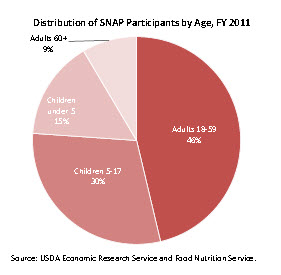With Molly O'Connor
The House would like to cut the program by approximately $40 billion over the next ten years. Some advocate separating the SNAP program from the farm bill. Before jumping to any conclusions or deciding on a course of action, however, let’s take a closer look at SNAP and those who rely on the program.
The current SNAP/food stamp program can be traced to the 1969 White House Conference on Food, Nutrition and Health. In 1969, President Nixon addressed the Conference and declared it was time to put an end to hunger and malnutrition in America. He went on to “accept the responsibility” on behalf of the Administration as a “moral imperative” but also laid out the practical considerations and identified the economic costs of hunger. As Nixon noted: “A child ill-fed is dulled in curiosity, lower in stamina, distracted from learning. A worker ill-fed is less productive, more often absent from work.”
After the White House Conference, in 1973 Congress phased out the USDA commodity distribution program in favor of the more nutritious food stamp program and extended it nation-wide. The Dole-McGovern Food Stamp Reform Act of 1977 then greatly reformed the program. It eliminated the purchase requirement (so that recipients no longer had to purchase their food stamps) and established a uniform national standard for eligibility and benefits. It also established a very strong work incentive; recipients who had earned income had their SNAP benefits reduced by only .25 cents for every dollar of income.
As a result, today the SNAP program is the most important nutrition program and income security safety net for low income people across the country.
From 1981 to 2003 participation remained at some 21 million people, with fluctuations during those years. Since 2003, as a result of the recession and higher unemployment rates, participation has increased sharply from 21 million people to 47 million people. The number of Americans living below the federal poverty level is at an all-time high. That fact is the principal reason there are 47 million people receiving SNAP benefits each month. The program is also reaching a higher percentage of those eligible because of technology that protects the privacy of those in the program. This change was particularly important to the elderly.
Out of the 47 million SNAP recipients, 87% are households with children, seniors or people with disabilities. According to a report by the Center on Budget and Policy Priorities, more than 21 million children live in households that receive SNAP benefits.

And what do those SNAP recipients get; what is the average benefit for those in the program? Up until a month ago, each participant in the SNAP program received, on average, $1.47 per meal. Then, on November 1, 2013, SNAP benefits were cut by $5 billion per year, or 13.6%, under the provisions of the American Recovery and Reinvestment Act. That was approximately $10/person/month. The impact was felt immediately as families ran out of food earlier in the month and food pantries saw a spike in participation. The benefit is now less than $1.40 per person per meal. That is the bottom line. There is no Thanksgiving feast on barely $1.40 per meal.
“SNAP provides $1.40 in food assistance, per person, per meal.
That is the bottom line.” Marshall Matz
Now, in the weeks ahead the Congress must address two major SNAP issues as a part of the Farm Bill Conference Committee: 1. How much more to cut the SNAP program; and 2. should SNAP continue to be reauthorized in the Farm Bill or separated into independent legislation. “At stake” according to former Senators Bob Dole (R-KS) and Tom Daschle (D-SD) writing in an LA Times Op-Ed “is the ability of millions of Americans who still struggle in our economy to provide adequate healthy meals for their children and families.
Historically, the food stamp program and farm subsidies were joined into one bill for both policy and political reasons. Again, quoting Dole and Daschle, “All of us benefit from the efficiency of our farmers and ranchers. We enjoy a safe and plentiful food system for less than 10% of our disposable income. In fact, Americans spend a smaller percentage of our disposable income on food than people in any other country. The special relationship in the legislative process between agriculture and those who need assistance from the SNAP program is also built on this tradition.”
The current size of SNAP makes it an obvious target for budget cuts. But the Congress should focus on the average benefit of barely $1.40 per person, per meal before voting on additional cuts to the program. The error rate in the SNAP has declined dramatically and steadily since the 1990’s. Any major cuts in program, as proposed by the House, are going to reduce benefits not fraud or waste.
Allow me to close as Dole and Daschle closed their Op Ed: “In a country struggling to emerge from the worst economic recession since the Depression, this is no time to play politics with hunger.”
Marshall Matz was formerly General Counsel to the Senate Select Committee on Nutrition. He served as Counsel to Senators McGovern and Dole in drafting the Dole-McGovern Food Stamp Reform Act of 1977. He currently specializes in food and agriculture law at OFW Law in Washington, D.C. mmatz@ofwlaw.com Molly O’Connor is a Legislative Assistant at OFW Law.
#30
For more news go to: www.Agri-Pulse.com

